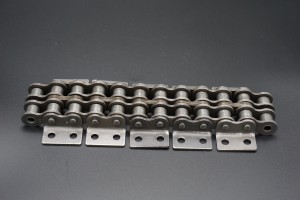In power transmission and lifting applications, chains play a vital role in ensuring smooth and efficient operation. Among the various types of chains used in industrial environments, roller chains and leaf chains are two popular choices. Although both serve similar purposes, there are significant differences in design, construction, and application. Understanding these differences is critical to selecting the chain that best suits specific industrial needs.
Roller chain:
Roller chains are one of the most widely used chain types in industrial applications. They consist of a series of cylindrical rollers connected together by inner and outer plates. The rollers are designed to reduce friction and provide smooth articulation as the chain engages the sprocket. This design allows for efficient power transfer and is ideal for high-speed and high-torque applications.
One of the main advantages of roller chains is their ability to handle heavy loads and withstand high stresses. This makes them ideal for use in machinery, conveyors, automotive systems and a variety of other industrial equipment requiring reliable power transmission. Roller chains are available in a variety of sizes and configurations to suit different load capacities and operating conditions.
Leaf chain:
On the other hand, plate chains are characterized by a simple and strong structure. They consist of chain plates connected by pins, creating a flexible and durable chain. Unlike roller chains, leaf chains have no rollers, which means they rely on the sliding action between pins and chain plates for articulation. This design makes leaf chains ideal for applications requiring straight line tension and minimal vibration.
Plate chains are commonly used in lifting and hoisting equipment such as forklifts, cranes and hoists to provide reliable and stable lifting capabilities. Their ability to handle static and dynamic loads makes them the first choice for vertical lifting applications. Leaf chains are available in different grades and sizes to suit different load capacities and operating conditions.
difference:
The main difference between roller chains and leaf chains is their design and intended application. Roller chains are designed for transmitting power and motion in high-speed, high-torque applications, while leaf chains are designed for lifting and hoisting applications. The presence of rollers in roller chains makes articulations smoother and reduces friction, making them suitable for continuous rotational motion. In contrast, leaf chains are designed to handle static and dynamic loads under straight-line tension, making them ideal for vertical lifting and hauling applications.
Another notable difference is the way these chains mesh with the sprockets. Roller chains utilize the teeth of rollers and sprockets to mesh to provide smooth and efficient power transmission. In contrast, leaf chains rely on sliding action between pins and plates to engage sprockets, making them ideal for applications requiring straight-line tension and minimal vibration.
In terms of maintenance, roller chains generally require more frequent lubrication due to the presence of rollers, and the rollers are prone to wear. Leaf chains, on the other hand, are designed to operate with minimal lubrication, making them suitable for applications where frequent maintenance may not be possible.
in conclusion:
In summary, although roller chains and leaf chains are important components in industrial machinery and equipment, they are designed for different purposes and applications. Roller chains are ideal for power transmission in high-speed, high-torque applications, while leaf chains excel in lifting and hoisting applications. Understanding the differences between these two types of chains is critical to choosing the most appropriate option based on specific operating requirements. By considering factors such as load capacity, operating conditions and maintenance needs, industrial professionals can make informed decisions when selecting roller and leaf chains for their applications.
Post time: May-29-2024

